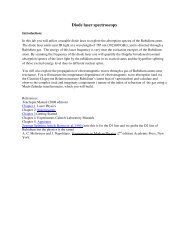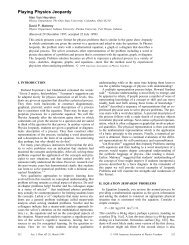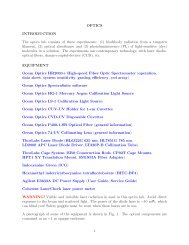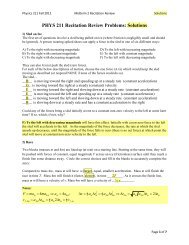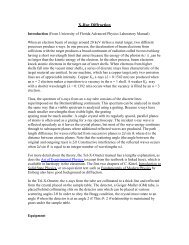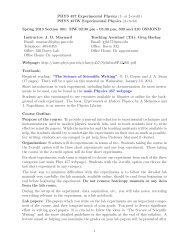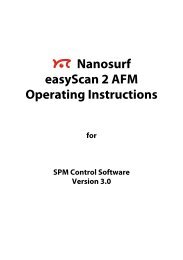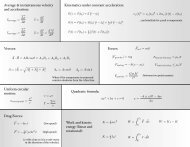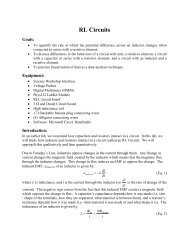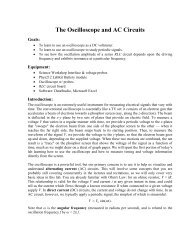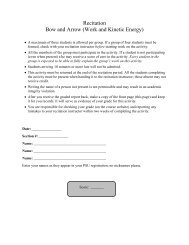Physics 250 Laboratory: Rotational Motion - Penn State University
Physics 250 Laboratory: Rotational Motion - Penn State University
Physics 250 Laboratory: Rotational Motion - Penn State University
You also want an ePaper? Increase the reach of your titles
YUMPU automatically turns print PDFs into web optimized ePapers that Google loves.
<strong>Physics</strong> <strong>250</strong> <strong>Laboratory</strong>:<br />
<strong>Rotational</strong> <strong>Motion</strong><br />
Score: _____<br />
Section #:______<br />
Name:_____________________________<br />
Name:_____________________________<br />
Name: _____________________________<br />
Lab-Specific Goals:<br />
• Examine the angular displacement, angular velocity, and angular acceleration of a rotating<br />
disc.<br />
• Relate linear and rotational motion.<br />
• Determine the coefficient of static friction between the turntable surface and a penny.<br />
• Predict the magnitude of the angular velocity that causes a penny at a given radius to slip.<br />
Equipment List:<br />
Rotating Platform with attached Rotary <strong>Motion</strong> Sensors<br />
Photogates<br />
Stickers located at two different radii<br />
Pulley<br />
String<br />
Hanging mass and hanger<br />
<strong>Penn</strong>y<br />
Ruler<br />
Index card piece and putty (for flag on disc)<br />
Introduction and Pre-Lab Questions:<br />
<strong>Rotational</strong> motion, where an object rotates about some<br />
internal axis, is a common form of motion: the earth<br />
rotating, an ice skater doing a turn, a car’s wheels spinning,<br />
etc. <strong>Rotational</strong> motion is closely connected to circular<br />
motion since any point on the rotating object undergoes<br />
circular motion around the axis. One of the goals of this lab<br />
activity is to explore and understand this connection.<br />
v t<br />
Δθ<br />
s<br />
r<br />
ω<br />
© 2009 <strong>Penn</strong> <strong>State</strong> <strong>University</strong><br />
1
The radius of a particle undergoing circular motion is always a constant. The angular position,<br />
however, will change with time depending on the motion of the particle. The angular quantities<br />
(θ, ω, α) for the object as a whole are related through geometry (specifically the radius) to the<br />
quantities for the point of interest (s, v t , a t ):<br />
Arc distance traveled<br />
Tangential velocity<br />
Tangential acceleration<br />
S<br />
v t<br />
a t<br />
s<br />
Δ θ = Angular displacement<br />
r<br />
v<br />
ω ≡ Δθ = t<br />
Δt<br />
r<br />
Angular velocity<br />
a<br />
α ≡ Δω = t<br />
Δt<br />
r<br />
Angular acceleration<br />
The relationships between the angular position θ, angular velocity ω, and angular acceleration α<br />
are exactly the same as the relationships previously determined for one-dimensional motion.<br />
Write below the angular equivalents of the X, V, and V 2 equations for constant (angular)<br />
acceleration:<br />
X :<br />
V :<br />
V 2 :<br />
A point on a rotating object experiences two kinds of acceleration:<br />
1) Centripetal acceleration (inwards<br />
towards the center of the circle)<br />
a<br />
c<br />
2<br />
vt<br />
= = ω 2 r<br />
r<br />
2) Tangential acceleration<br />
(tangent to the circle)<br />
a t = rα<br />
The total acceleration is the vector sum of a c and a t :<br />
a 2 = a c 2 + a t<br />
2<br />
© 2009 <strong>Penn</strong> <strong>State</strong> <strong>University</strong><br />
2
Q1) At a given instant, a disc is rotating with an angular velocity of 10 rad/s and accelerating at 2<br />
rad/s 2 . Consider a particle on the disc with mass 0.05 kg and a distance 0.2 meters from the axis.<br />
a) What is the centripetal acceleration of this point?<br />
b) What is the tangential acceleration of this point?<br />
c) What is the total acceleration of this point?<br />
d) What is the net force acting on this point?<br />
e) Which of these types of acceleration will change over time for this object? Why?<br />
Q2) Two pennies start on a spinning disc – one near the center and one near the edge of the disc.<br />
Which penny will be more likely to fall off the disc and why?<br />
Q3) A disc is initially at rest, but is undergoing a constant counter-clockwise angular<br />
acceleration. Make qualitative sketches for the angular position θ, angular velocity ω and angular<br />
acceleration α as a function of time.<br />
θ<br />
t<br />
ω<br />
t<br />
α<br />
t<br />
© 2009 <strong>Penn</strong> <strong>State</strong> <strong>University</strong><br />
3
Introductory Activity: Using the Rotating Disc<br />
1. Measure the radius of the circle created by the outer blue sticker, R o (from center of disc to<br />
center of blue circle).<br />
R o = ___________________ meters<br />
2. Measure the radius of the circle created by the inner yellow sticker, R i .<br />
R i = ___________________ meters<br />
3. Carefully rewind the string around the base of the turntable and place the string over the<br />
pulley with the hanging mass attached. If your turntable apparatus has multiple radii around<br />
which the string can be wrapped, but sure to use the same one every time. Make sure the<br />
string remains on the pulley.<br />
4. You will need to use the same hanging mass the entire time. For Activity 2, the hanging mass<br />
must be large enough to cause a penny to slip at both the blue and yellow positions, but small<br />
enough to keep it from slipping too quickly. Find a hanging mass that fits these criteria:<br />
Hanging mass: m = ___________________ kg (typically about 150 grams)<br />
© 2009 <strong>Penn</strong> <strong>State</strong> <strong>University</strong><br />
4
Activity 1: Kinematics of Circular <strong>Motion</strong><br />
Develop a procedure to collect the data required to graph the angular velocity (ω) versus time for<br />
this system. Some hints:<br />
(1) you can use pulse mode with one photogate to determine the time it takes to make the<br />
first, second, third, etc. rotations and from that determine θ(t). From these measurements<br />
you can find α and then ω(t).<br />
(2) you can use gate mode with one photogate to find the tangential speed v t (and thus the<br />
angular velocity ω) at the end of each rotation and from this determine α and then ω(t).<br />
(3) You may need to do multiple runs to get one full set of data since the photogate timer will<br />
only store one or two times for a single run.<br />
Sketch and explain your procedure below. (Start with the system initially at rest.)<br />
© 2009 <strong>Penn</strong> <strong>State</strong> <strong>University</strong><br />
5
Label the headings in Table 1 to match the data and calculations that you will be doing. Then<br />
collect your data and fill in the table. Show your calculations for your first measurement below:<br />
Table 1: Data for Lab Activity 1<br />
Now graph your data on the next page. What data point do you already know without collecting<br />
any data? (And how do you know this point must be there?)<br />
© 2009 <strong>Penn</strong> <strong>State</strong> <strong>University</strong><br />
6
Graph 1: Angular velocity ω as a function of time<br />
© 2009 <strong>Penn</strong> <strong>State</strong> <strong>University</strong><br />
7
Draw a best fit line (making sure to go through the origin) to your angular velocity as a<br />
function of time graph.<br />
What is the angular acceleration α in your system? Explain below how you find α and what<br />
value you get. (Record your hanging mass and value for α on the Class Data Sheet.)<br />
What is the tangential acceleration of a point at the very edge of the disc? (Show how you<br />
determine this from α.)<br />
What is the angular displacement Δθ for the disc from t=0 to the maximum time shown on your<br />
graph? (Show how you determine this from your graph.)<br />
© 2009 <strong>Penn</strong> <strong>State</strong> <strong>University</strong><br />
8
Activity 2: The Dynamics of Circular <strong>Motion</strong><br />
You are going to predict the angular velocity at which the penny will slip from one radius using<br />
your measurements of when the penny slips at a different radius. Because the penny will be<br />
spinning it will have an inwards centripetal acceleration of<br />
a c = v t 2 /r = ω 2 r.<br />
Since the disc is angularly accelerating, it also has a tangential acceleration<br />
a t = rα.<br />
Remember that tangential acceleration is a measure of the rate change of the tangential (and<br />
therefore, angular) speed of the object, i.e., the magnitude of the velocity vector. Centripetal<br />
acceleration is a measure of the rate at which the direction of the object changes at every<br />
moment.<br />
The magnitude of acceleration is then given by the vector sum of a c and a t . Since they are<br />
perpendicular to each other, we can use the Pythagorean theorem:<br />
a 2 = a c 2 + a t 2 .<br />
α<br />
ω<br />
α<br />
ω<br />
v a a c<br />
a t<br />
f s<br />
Figure 1 (Left): a view from above of the turntable, showing at one instant the penny’s instantaneous acceleration<br />
and velocity. We break the acceleration into centripetal and tangential components. (Right): the only horizontal<br />
force acting on the penny to provide it with the acceleration necessary to move with the turntable is that of static<br />
friction. Because it is the only horizontal force acting (and the vertical forces balance) we can say that the static<br />
frictional force must be the net force on the penny.<br />
The penny is held in place by static friction. Recall that static friction is a variable force, able to<br />
provide resistance up to a particular maximum value:<br />
f s,max = µ s n<br />
© 2009 <strong>Penn</strong> <strong>State</strong> <strong>University</strong><br />
9
Part I: Determine the Coefficient of Static Friction on the Turntable<br />
1. Place a penny at a distance, R o , from the center of the turntable. [Note: Do not place the<br />
penny directly on top of the blue sticker, just at the same radial distance from the center.]<br />
2. Release the turntable from rest and determine the angular velocity of the turntable when<br />
the penny slips. (Remember, you already know the angular velocity as a function of time<br />
from Activity 1!) [You can use the photogate timer as a stopwatch, by pushing to<br />
start/stop button.]<br />
You will want to do several runs to get a good average time (and thus average ω):<br />
______________ _______________ ________________ _______________<br />
______________ _______________ ________________ _______________<br />
3. For the moment just prior to when the penny slipped, calculate the linear (tangential)<br />
velocity, the tangential acceleration, and the centripetal acceleration of the penny. (Note:<br />
The tangential acceleration will likely be much smaller in magnitude than the centripetal<br />
acceleration.) Record your results and explain your calculations in the table below.<br />
4. Determine the coefficient of static friction between the turntable surface and the penny.<br />
Record your results and explain your calculations in the table below. Clearly and<br />
completely explain your method of calculating µ s . Record your value for µ on the Class<br />
Data Sheet. (Note: you do not need to find the mass of the penny to solve for µ.)<br />
Quantity Result Explanation of how Result was obtained…<br />
R o = Radius (meters)<br />
ω = Angular Velocity (rad/s)<br />
This radius was measured using a ruler in the<br />
introductory activity.<br />
α = Angular Acceleration (rad/s 2 ) Measured in Activity 1.<br />
v t = Tangential Velocity (m/s)<br />
a t = Tangential Accel. (m/s 2 )<br />
a c = Centripetal Accel. (m/s 2 )<br />
a = magnitude of acceleration<br />
(m/s 2 )<br />
µ s = Coefficient of Static Friction<br />
© 2009 <strong>Penn</strong> <strong>State</strong> <strong>University</strong><br />
10



